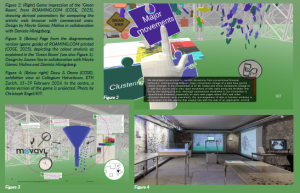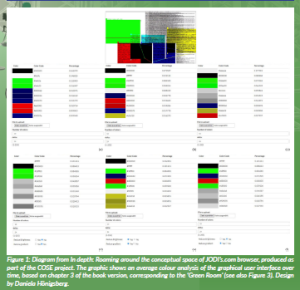Professor Dr Inge Hinterwaldner, Daniela Hönigsberg, Yannick Westphal, Jiawen Yao, Mayte Gómez Molina
Karlsruhe Institute of Technology
Software and hardware obsolescence threaten our born-digital cultural heritage. The gaps we leave in describing coded artworks today will be what remains unknown tomorrow. COSE developed a multi-perspectival approach and hybrid formats combining documentation with argumentation. Reaching out to different audiences, our study on the artwork.COM by JODI is rendered as a book, interactive game and game guide.
How do we, as societies, deal with the fact that every software update threatens our digital cultural heritage? How can we secure a rich memory of programmed artworks once they no longer function? In art history, our established documentation procedures in publications entail screenshots and photos. We show why and where this is inadequate for building a sustainable knowledge base. We developed a number of methodological and communicative measures to aid us in preserving our fragile and precarious cultural artefacts.
These include:
- an interdisciplinary and multi-perspectival approach
- a hybrid form combining documentation and argumentation
- a threefold publication strategy. The last of these is an experiment in science communication.
Case study
To create close readings or ‘extended portraits’ of net art pieces (as presented in PRj 15, October 2022, 100–104), COSE started by analysing Wrong Browser. COM (2001, see Figure 1b on top). This is a seminal artistic web browser by the pioneering net art duo JODI. As with basically all web browsers, users can enter URLs and initiate searches. Besides these basic functions,.COM has a pro-active behaviour. It autonomously calls websites within the domain name after which it was named. In other words, it is a usable, programmed, process-based, networked artwork that exhibits a certain complexity. Often, published academic scholarship on programmed artworks only scratches the surface of what is happening. Gaining insight into their tectonics and logic paves the way for acknowledging the choices, craft and invention that lead to the specific outcome. Grasping their richness is the first step towards recognising and developing societal care for our digital cultural heritage.
i. Multi-perspectival approach
We explored the inner workings of this coded artwork from four perspectives—art history [1], data design [2], artistic hacking/ forensics [3] and digital humanities [4]. These different analytical views are designed collaboratively, yet the interests and backgrounds of the scholars taking the lead show through. Each chapter/ room features a specific train of thought and set of methods used to create that cognitive space.
- In [1], we conceived the browser in its three- or four-dimensionality. We investigated the interplay between the visual elements and auditive signals in the user interface to determine some underlying rules and draw some conclusions related to the communicative power of the browser.
- In [2], we matched specific definitions from the source code with the phenomenological consequences in the GUI. This focus regards the embedding of regular and random processes in temporal events and spatial placements.
- In [3], we were interested in how to define, retrieve, extract, and visualise data from the runtime process of the web browser so that an automated examination/evaluation could be possible. This is developed with a software visualisation tool in mind and conceptually works towards tool-based digital humanities approaches.
- In [4], we operated with a large toolset for software analysis and brought technical insights as well as media archaeological information to light. By retrieving and ‘x-raying’ different versions of that browser, with forensic methods, we could look into its genealogy.
In terms of content, our study is supposed to be eye-opening for all who are curious about how a programmed piece of software (art) works and how one could unlock some of its dimensions. All our inquiries focused on the inner workings of the browser—its components, relations, assets, dynamics and expressions, and we mapped out different roads to create the original conceptual spaces we required to frame our findings. The more facets we laid out, the more thematic connections we could offer and the greater the artwork’s sustainability to serve as a point of reference. Touching more of its facets made it more likely that this work will remain relatable and thus relevant in the future. We sought to foreground (often omitted) dimensions and aspects that humanists could examine critically. Focusing on those, we showed that some observations and surprising conclusions could not be reached without digging deeply into the work. Some facets only come into view after long observation periods, adopting specialised analytic tools, retracing the source code, etc. Needless to say, only then could the scholars build arguments with these facets.
ii. Interlacing data collection and storytelling
Where existing literature dedicated, on average, just a few lines of text to Wrong Browser.COM—and this seems representative—we wrote a book. Our point is not that this particular case was neglected. Our point is that the neglect is systemic. The issue is less one of completeness and more one of principle. The recognition that coded artworks are tiny universes to be explored is not yet a widely adopted view. Consequently, scholars in art history have not felt the necessity to empower themselves with the skillset needed to retrace the various dimensions involved. Thus, for instance, digital humanities’ methods are rarely used for born-digital art. Another consequence is that art historians are engaged in spinning a web of references, ideas and concepts around the artworks. This is valuable.
However, the underlying attitude implies the assumption that the object of study will persist. Such contextual writings or theory levels are only remotely and moderately useful for any preservationist tasked with restoring a ‘broken’ art piece. While it is true that art theory and media conservation are different disciplines with their own main areas of focus, they could work together to build a comprehensive knowledge of at least the very best examples of born-digital art.
COSE contributes by prototyping a bridge between academic argumentation and a systematic inventory. Our chosen approach includes information readers/players would normally expect in documentation, inventory-taking or critical editions. The integrated documentation is due to our conviction that we must encapsulate all important information for the (likely) case that the artwork itself will be lost to software obsolescence. Which data are integrated? How do we express and interpret our diverse perspectives? How does this differ from a technical boxing done with emulation techniques? One future interest will be to ‘interface’ with digital conservators’ approaches.
iii. Model building in the humanities
How do we build models in the humanities? We produce detailed descriptions of the case study. We summarise them as statistical statements or rules whenever possible and condense these insights into pictorial forms (Figure 1). Together with the accompanying text, these visualisations—be they animations or 3D models—create a knowledge space that shows the connections to recognisable features of the object of study. This way, the statements are situated where they formulate a reference. It may be possible to ‘prove’ a mechanism on the spot with the help of a model.
COSE provides an example for building models in the humanities and shows how this can open multiple venues for different types of publications for the dissemination of knowledge. The study’s argumentation is supported by visualisations, which the group has also nested in visualisation clusters or strings. By creating their own visualisations, researchers can better communicate their insights and support readers’ understanding.
The technique of summarising the main messages using image clusters has been perfected by scientists from the STEM fields over decades. The sociologist Martina Merz has shown that, in scientific articles, information passes more efficiently when images are mutually cross-referenced in clusters. In contrast, art historians still tend to publish their visual material as isolated singular entities. COSE’s path aligns more with methods commonly used in the natural sciences while retaining the curiosities and questions cultivated in the humanities and the arts. COSE took several steps towards exploring a metaphor-based pictorial language to exploit everyday intuitions for fostering understanding in our outputs. Once we had adopted image clusters to help tell our story and argumentation, a next level of science communication came into view.
Threefold publication
Our study resulted in a threefold publication enterprise and took the form of (a) a printed book with four chapters, each featuring different aspects of the artwork, (b) an interactive Unity-based computer game with four main rooms that involved compressing text and expanding modelling (Figure 2), and (c) a diagrammatic rendering of the game (Figure 3) in a printed book which involved compressing the game impressions but keeping an exploratory pathway.
- Unfolding coded artworks: Analytical journeys through JODI’s.com browser, Daniela Hönigsberg, Mayte Gómez Molina, Jiawen Yao, Yannick Westphal and Inge Hinterwaldner (under review)
- COM, Mayte Gómez Molina, Daniela Hönigsberg, Yannick Westphal, Jiawen Yao and Inge Hinterwaldner, in collaboration with game programmer Andy DiLallo (release date: January 25)
- COM printed: Paper-based ways of exploring an %WRONG Browser by JODI
Jiawen Yao, Mayte Gómez Molina, Daniela Hönigsberg, Yannick Westphal and Inge Hinterwaldner, in Estelle Blaschke, Mario Schulze and Sarine Waltenspül (eds), Visual science and technology studies: Perspectives, Intercom: Zurich, 2025 (forthcoming)
Transforming a thorough scholarly argumentation into an explorable multimedia environment is new territory in terms of academic knowledge transfer. By combining textual analysis with visual clusters and interactive models, our ‘walk-through book’ offers a dynamic and engaging way to present net-based art. It expands standards for how digital art can be described and studied, ensuring that even intricate and fragile works remain accessible for future research. The printed game guide will outlive the game itself as this is built on volatile software-based grounds. All three variants of our publication are meant to reach different publics and to spark their enthusiasm about the phenomena shown. Understanding and empathic interest are urgently needed to preserve the highlights of programmed art from software obsolescence-induced oblivion. This is to engage different publics and to address all who care about our digital cultural heritage.
Some of these publication formats are suitable for conquering new dissemination venues. In February 2024, the COSE projects were on show at ETH Zurich, Switzerland (Figure 4), featuring original ‘haptic’ research results with hands-on exploration opportunities.
Acknowledgement
We thank the artists Joan Heemskerk and Dirk Paesmans for their generous support of our research. We are grateful to Andy DiLallo, who helped us implement the game version.
PROJECT NAME
COSE
PROJECT SUMMARY
The ERC CogGrant COSE project focuses on internet-based art that is not accessible in a straightforward manner and thus easily overlooked or lost. We develop new hybrid methods to retrieve and analyse online art and its embeddedness in sociotechnological environments. With COSE’s MediaWiki archive, we hope to kickstart a future research environment for scholars.
PROJECT PARTNERS
COSE is based in Karlsruhe and thus enjoys the vicinity of its most prominent cooperation partner, ZKM | Center for Art and Media, a seminal cultural institution for new media art. So far, cooperation partners include scholars from Europe and the US and come from the fields of software visualisation, digital art conservation and internet studies.
PROJECT LEAD PROFILE
Inge Hinterwaldner received her PhD in art history from the University of Basel with a thesis on computer simulations. Since 2018 she has been a professor of art history at KIT. Starting from 1998, she has been working on net art and many more genres of digital imagery. She is interested in programmed art and the crossover of art, technology and science.
PROJECT CONTACTS
Prof. Dr Inge Hinterwaldner
Karlsruhe Institute of Technology Institute History of Art and Architecture Englerstr. 7, D-76131 Karlsruhe
Email: Inge.Hinterwaldner@kit.edu
Web: https://kg.ikb.kit.edu/hinterwaldner/3068.php
Figure legends
Figure 1: Diagram from In depth: Roaming around the conceptual space of JODI’s.com browser, produced as part of the COSE project. The graphic shows an average colour analysis of the graphical user interface over time, based on chapter 3 of the book version, corresponding to the ‘Green Room’ (see also Figure 3). Design by Daniela Hönigsberg.
Figure 2: (Right) Game impression of the ‘Green Room’, from ROAMING.COM (COSE, 2025), showing derived parameters for comparing the artistic web browser with commercial ones. Design by Mayte Gómez Molina in collaboration with Daniela Hönigsberg.
Figure 3: (Below) Page from the diagrammatic version (game guide) of ROAMING.COM printed (COSE, 2025), depicting the colour analysis as explained in the ‘Green Room’ (see also Figure 1). Design by Jiawen Yao in collaboration with Mayte Gómez Molina and Daniela Hönigsberg.
Figure 4: (Below right) Docu & Demo (COSE), exhibition view at Collegium Helveticum, ETH Zurich, 15–29 February 2024. In the centre, a demo version of the game is projected. Photo by Christoph Engel/KIT.



